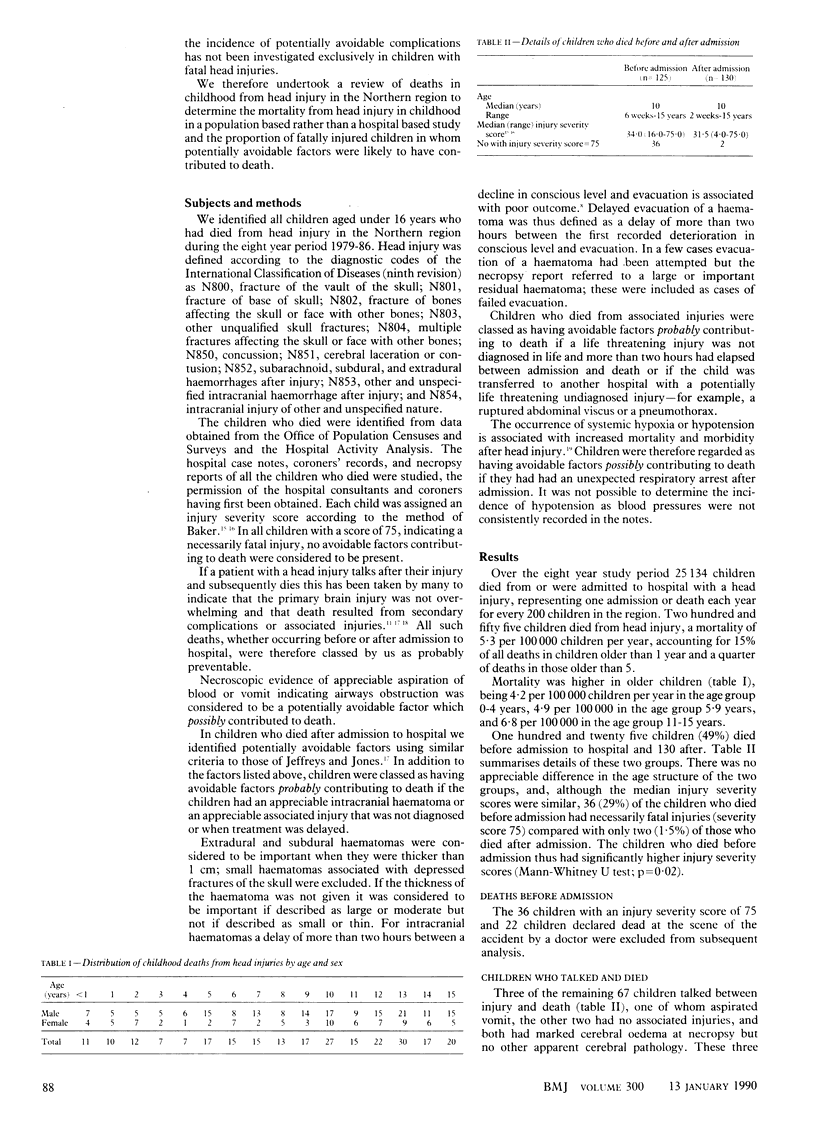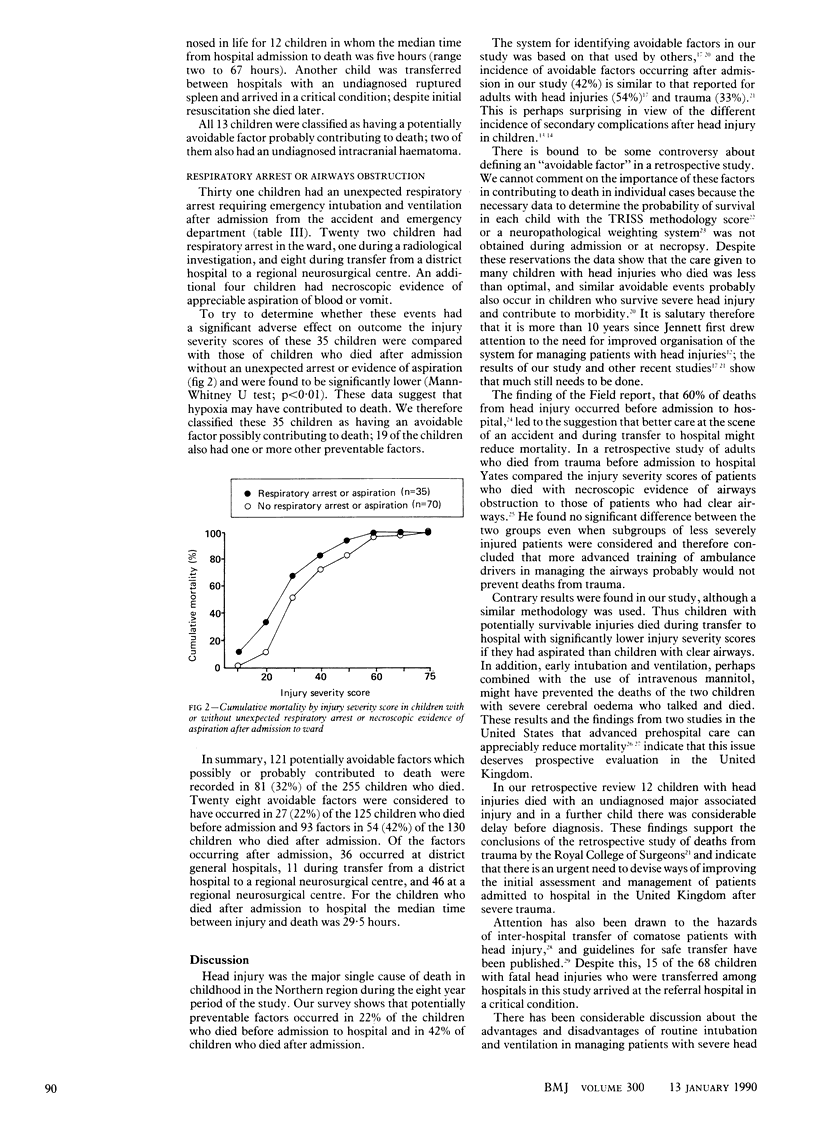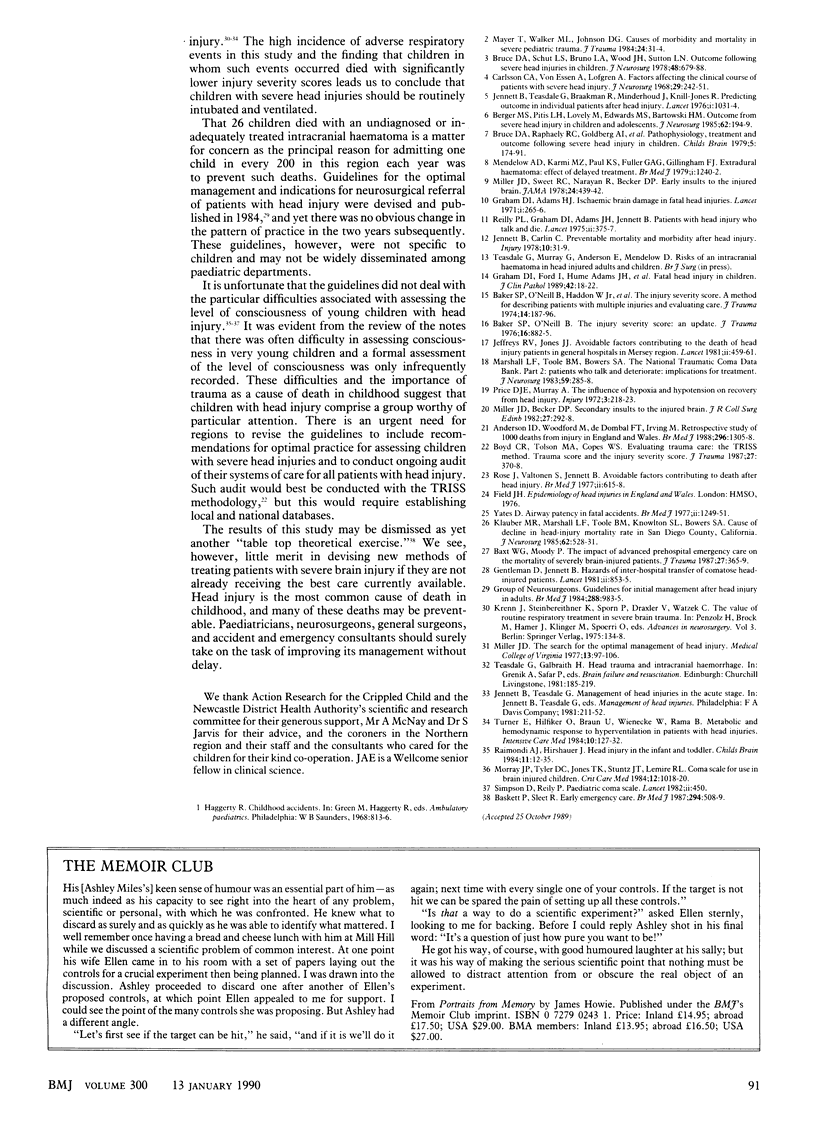Abstract
OBJECTIVE--To assess the incidence of potentially avoidable complications contributing to death of children with head injuries. DESIGN--Retrospective review of children who died with head injuries from 1979 to 1986 from data of the Office of Population Censuses and Surveys, Hospital Activity Analyses, case notes, coroners' records, and necropsy reports. SETTING--District general hospitals and two regional neurosurgical centres in Northern region. RESULTS--255 Children died from head injury in the region, the mortality being 5.3 per 100,000 children per year. Head injury was the single most important cause of death in children aged greater than 1 year, accounting for 15% of deaths in children aged 1-15 years and a quarter for those aged 5-15 years. 121 Potentially avoidable factors possibly or probably contributing to death occurred in 81 children (32%). Half the children (125) died before admission, 27 of whom (22%) had potentially avoidable factors possibly or probably contributing to death, and 130 died after admission, 54 of whom (42%) had 93 such factors, which included failure of diagnosis or delayed recognition of intracranial haemorrhage or associated injury, inadequate management of the airways, and poor management of the transfer between hospitals. IMPLICATIONS--Regions should revise urgently their guidelines for optimal management and indications for neurosurgical referral to include children with severe head injuries and audit their systems of care for all patients with head injuries.
Full text
PDF




Selected References
These references are in PubMed. This may not be the complete list of references from this article.
- Anderson I. D., Woodford M., de Dombal F. T., Irving M. Retrospective study of 1000 deaths from injury in England and Wales. Br Med J (Clin Res Ed) 1988 May 7;296(6632):1305–1308. doi: 10.1136/bmj.296.6632.1305. [DOI] [PMC free article] [PubMed] [Google Scholar]
- Baker S. P., O'Neill B., Haddon W., Jr, Long W. B. The injury severity score: a method for describing patients with multiple injuries and evaluating emergency care. J Trauma. 1974 Mar;14(3):187–196. [PubMed] [Google Scholar]
- Baker S. P., O'Neill B. The injury severity score: an update. J Trauma. 1976 Nov;16(11):882–885. doi: 10.1097/00005373-197611000-00006. [DOI] [PubMed] [Google Scholar]
- Baskett P., Sleet R. Early emergency care. Br Med J (Clin Res Ed) 1987 Feb 21;294(6570):508–509. doi: 10.1136/bmj.294.6570.508-c. [DOI] [PMC free article] [PubMed] [Google Scholar]
- Baxt W. G., Moody P. The impact of advanced prehospital emergency care on the mortality of severely brain-injured patients. J Trauma. 1987 Apr;27(4):365–369. doi: 10.1097/00005373-198704000-00004. [DOI] [PubMed] [Google Scholar]
- Berger M. S., Pitts L. H., Lovely M., Edwards M. S., Bartkowski H. M. Outcome from severe head injury in children and adolescents. J Neurosurg. 1985 Feb;62(2):194–199. doi: 10.3171/jns.1985.62.2.0194. [DOI] [PubMed] [Google Scholar]
- Boyd C. R., Tolson M. A., Copes W. S. Evaluating trauma care: the TRISS method. Trauma Score and the Injury Severity Score. J Trauma. 1987 Apr;27(4):370–378. [PubMed] [Google Scholar]
- Bruce D. A., Raphaely R. C., Goldberg A. I., Zimmerman R. A., Bilaniuk L. T., Schut L., Kuhl D. E. Pathophysiology, treatment and outcome following severe head injury in children. Childs Brain. 1979;5(3):174–191. doi: 10.1159/000119817. [DOI] [PubMed] [Google Scholar]
- Bruce D. A., Schut L., Bruno L. A., Wood J. H., Sutton L. N. Outcome following severe head injuries in children. J Neurosurg. 1978 May;48(5):679–688. doi: 10.3171/jns.1978.48.5.0679. [DOI] [PubMed] [Google Scholar]
- Carlsson C. A., von Essen C., Löfgren J. Factors affecting the clinical corse of patients with severe head injuries. 1. Influence of biological factors. 2. Significance of posttraumatic coma. J Neurosurg. 1968 Sep;29(3):242–251. doi: 10.3171/jns.1968.29.3.0242. [DOI] [PubMed] [Google Scholar]
- Gentleman D., Jennett B. Hazards of inter-hospital transfer of comatose head-injured patients. Lancet. 1981 Oct 17;2(8251):853–854. doi: 10.1016/s0140-6736(81)91115-6. [DOI] [PubMed] [Google Scholar]
- Graham D. I., Adams J. H. Ischaemic brain damage in fatal head injuries. Lancet. 1971 Feb 6;1(7693):265–266. doi: 10.1016/s0140-6736(71)91003-8. [DOI] [PubMed] [Google Scholar]
- Graham D. I., Ford I., Adams J. H., Doyle D., Lawrence A. E., McLellan D. R., Ng H. K. Fatal head injury in children. J Clin Pathol. 1989 Jan;42(1):18–22. doi: 10.1136/jcp.42.1.18. [DOI] [PMC free article] [PubMed] [Google Scholar]
- Jeffreys R. V., Jones J. J. Avoidable factors contributing to the death of head injury patients in general hospitals in Mersey Region. Lancet. 1981 Aug 29;2(8244):459–461. doi: 10.1016/s0140-6736(81)90786-8. [DOI] [PubMed] [Google Scholar]
- Jennett B., Carlin J. Preventable mortality and morbidity after head injury. Injury. 1978 Aug;10(1):31–39. doi: 10.1016/s0020-1383(79)80044-3. [DOI] [PubMed] [Google Scholar]
- Jennett B., Teasdale G., Braakman R., Minderhoud J., Knill-Jones R. Predicting outcome in individual patients after severe head injury. Lancet. 1976 May 15;1(7968):1031–1034. doi: 10.1016/s0140-6736(76)92215-7. [DOI] [PubMed] [Google Scholar]
- Klauber M. R., Marshall L. F., Toole B. M., Knowlton S. L., Bowers S. A. Cause of decline in head-injury mortality rate in San Diego County, California. J Neurosurg. 1985 Apr;62(4):528–531. doi: 10.3171/jns.1985.62.4.0528. [DOI] [PubMed] [Google Scholar]
- Marshall L. F., Toole B. M., Bowers S. A. The National Traumatic Coma Data Bank. Part 2: Patients who talk and deteriorate: implications for treatment. J Neurosurg. 1983 Aug;59(2):285–288. doi: 10.3171/jns.1983.59.2.0285. [DOI] [PubMed] [Google Scholar]
- Mendelow A. D., Karmi M. Z., Paul K. S., Fuller G. A., Gillingham F. J. Extradural haematoma: effect of delayed treatment. Br Med J. 1979 May 12;1(6173):1240–1242. doi: 10.1136/bmj.1.6173.1240. [DOI] [PMC free article] [PubMed] [Google Scholar]
- Miller J. D., Becker D. P. Secondary insults to the injured brain. J R Coll Surg Edinb. 1982 Sep;27(5):292–298. [PubMed] [Google Scholar]
- Miller J. D., Sweet R. C., Narayan R., Becker D. P. Early insults to the injured brain. JAMA. 1978 Aug 4;240(5):439–442. [PubMed] [Google Scholar]
- Morray J. P., Tyler D. C., Jones T. K., Stuntz J. T., Lemire R. J. Coma scale for use in brain-injured children. Crit Care Med. 1984 Dec;12(12):1018–1020. doi: 10.1097/00003246-198412000-00002. [DOI] [PubMed] [Google Scholar]
- Price D. J., Murray A. The influence of hypoxia and hypotension on recovery from head injury. Injury. 1972 Apr;3(4):218–224. doi: 10.1016/0020-1383(72)90104-0. [DOI] [PubMed] [Google Scholar]
- Raimondi A. J., Hirschauer J. Head injury in the infant and toddler. Coma scoring and outcome scale. Childs Brain. 1984;11(1):12–35. doi: 10.1159/000120157. [DOI] [PubMed] [Google Scholar]
- Reilly P. L., Graham D. I., Adams J. H., Jennett B. Patients with head injury who talk and die. Lancet. 1975 Aug 30;2(7931):375–377. doi: 10.1016/s0140-6736(75)92893-7. [DOI] [PubMed] [Google Scholar]
- Rose J., Valtonen S., Jennett B. Avoidable factors contributing to death after head injury. Br Med J. 1977 Sep 3;2(6087):615–618. doi: 10.1136/bmj.2.6087.615. [DOI] [PMC free article] [PubMed] [Google Scholar]
- Simpson D., Reilly P. Pediatric coma scale. Lancet. 1982 Aug 21;2(8295):450–450. doi: 10.1016/s0140-6736(82)90486-x. [DOI] [PubMed] [Google Scholar]
- Turner E., Hilfiker O., Braun U., Wienecke W., Rama B. Metabolic and hemodynamic response to hyperventilation in patients with head injuries. Intensive Care Med. 1984;10(3):127–132. doi: 10.1007/BF00265801. [DOI] [PubMed] [Google Scholar]
- Yates D. W. Airway patency in fatal accidents. Br Med J. 1977 Nov 12;2(6097):1249–1251. doi: 10.1136/bmj.2.6097.1249. [DOI] [PMC free article] [PubMed] [Google Scholar]


